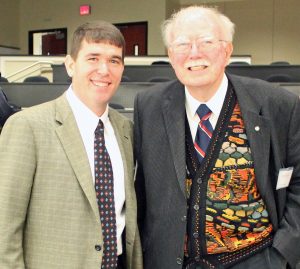
TUSCALOOSA, Ala. — A new lecture series to honor a University of Alabama emeritus professor aims to present high visibility topics in the fields of metallurgical and materials engineering and design to students and the public.
The annual lecture series honors Dr. Richard C. Bradt, professor emeritus at The University of Alabama, and is sponsored by Engineering Systems Inc., or ESI. Dr. Michael Stevenson, a former graduate student of Bradt’s, is president and CEO of ESI and gave the inaugural presentation.
A registered Professional Engineer who earned his bachelor’s, master’s and doctoral degrees in metallurgical and material engineering at UA, Stevenson’s lecture on materials failure analysis was titled “Structure, Properties, Design and Performance: The Role of Fundamental Engineering Principles in Major Accident Investigations.”
Bradt’s distinguished career was recently recognized by the American Ceramic Society, which selected Bradt for the W. David Kingery Award that recognizes distinguished, lifelong achievements involving multidisciplinary and global contributions to ceramic technology, science, education and art. The award is open to all people worldwide. It is the highest award of recognition by the American Ceramic Society.
He joined the faculty at The University of Alabama College of Engineering in 1994 as head of the department of metallurgical and materials engineering. In 2003, he was named the Alton N. Scott Professor of Materials Engineering. He retired in 2009, but he has remained an active researcher, speaker and educator.
Bradt’s research remains focused on the various areas of ceramics and mechanical properties of materials. His specialty is the fracture mechanics of brittle materials, and he is especially known worldwide for his research on the fracture of glass. He is an internationally recognized researcher who has received more than 20 national and international honors and awards for his teaching and research.
Through his research, he has published more than 400 journal papers in the technical areas of ceramics, glass and materials and edited more than 20 proceedings of international meetings. He has advised or co-advised the research of more than 100 graduate students and directed 50 doctoral theses.
In 1998, the University awarded Bradt the John P. Burnum Outstanding Faculty Award, and, in 2000, he received the international Academic Achievement Award from the Ceramic Society of Japan. Bradt was recognized with the Fellow designation from two different professional societies, the ASM International and the American Ceramic Society. He is also a Distinguished Life Member of the Unified International Technical Conference on Refractories.
Stevenson, who earned his doctorate from UA in 2001, specializes in the performance and analysis of engineering materials and systems in a variety of applications, and he has conducted complex, multidisciplinary failure investigations pertaining to buried infrastructure systems, structural failures, vehicles, and industrial and consumer products. His experience spans a wide range of industries, and it includes failure analysis of systems and components used in marine, automotive, all-terrain vehicle, aerospace, biomedical, crane, rail, structural, power generation and utility infrastructure applications.
Throughout his professional career, Stevenson has been actively involved in industry-leading technical organizations, and he has served in a variety of key leadership roles, including chairman of the Failure Analysis Committee of ASM International, and his current role as editor-in-chief of the ASM International’s Journal of Failure Analysis and Prevention. He is a sought after speaker, and he is widely published with more than 45 publications in major technical journals. Stevenson has also authored more than 300 technical reports, and he provided testimony in matters pending before both state and federal courts.
Stevenson serves on the Industrial Advisory Board for the department of aerospace engineering and mechanics. His technical interests include dynamic mechanical properties of materials, indentation hardness testing, fatigue and fracture mechanics, applied techniques for failure analysis, high strain rate material mechanics, and the performance of copper and copper alloys in extreme mechanical/chemical environments.
In 1837, The University of Alabama became one of the first five universities in the nation to offer engineering classes. Today, UA’s fully accredited College of Engineering has more than 4,100 students and about 120 faculty. Students in the College have been named USA Today All-USA College Academic Team members, Goldwater, Hollings, Portz and Truman scholars.
Contact
Adam Jones, engineering public relations, 205/348-6444, acjones12@eng.ua.edu